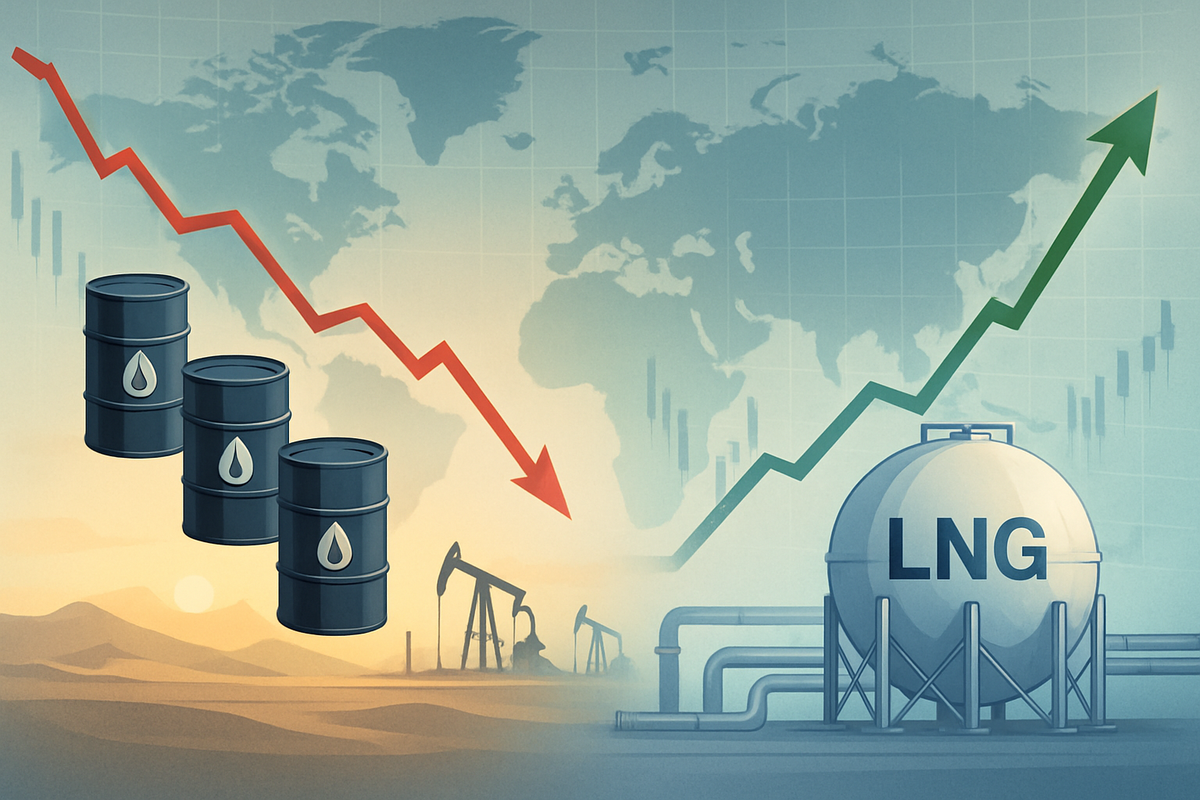Financial News
Global Commodities Take a Breather as Geopolitical Tensions Ease, Oil Prices Dip

New York, NY – October 9, 2025 – Global commodity markets concluded trading on October 9, 2025, with a notable downward trend in crude oil prices, largely influenced by a significant de-escalation of geopolitical tensions in the Middle East and an uptick in global inventories. Natural gas, while experiencing a daily dip, maintained a resilient long-term outlook, reflecting a dynamic interplay of supply, demand, and evolving energy landscapes.
The day's trading saw both WTI and Brent crude futures slide, as a breakthrough in peace negotiations between Israel and Hamas signaled a potential reduction in supply risks previously priced into the market. This shift in sentiment, coupled with growing concerns over an impending supply surplus, has reshaped the immediate outlook for the energy sector, prompting investors to reassess their positions in a rapidly changing environment.
Crude Oil Retreats as Peace Prospects Emerge; Natural Gas Navigates Supply Dynamics
On October 9, 2025, the energy markets registered significant movements. West Texas Intermediate (WTI) crude oil futures for November delivery settled down $1.04, or 1.7%, closing at $61.51 per barrel. Similarly, Brent crude oil for December delivery slumped $1.08, settling at $65.17 per barrel, marking a 1.04% decrease from the previous day. These declines represent a continuation of a bearish trend for crude, which had seen both benchmarks hit four-month lows earlier in the week before a brief recovery.
The primary catalyst for this downturn was the reported agreement between Israel and Hamas on the initial phase of a peace plan, including a ceasefire and hostage release in Gaza. This crucial development alleviated the geopolitical risk premium that had been supporting oil prices, as the threat of wider regional conflict impacting oil supply chains diminished significantly. Concurrently, US crude inventories rose for the second consecutive week, contributing to the bearish sentiment. This increase in stockpiles, coupled with robust global supply from OPEC+ production ramps and projected record-high US crude output, has fueled expectations of an emerging market surplus in the coming months. The International Energy Agency (IEA) and Goldman Sachs have further reinforced this view, forecasting that crude oil prices may face continued headwinds as supply growth surpasses demand.
In contrast, natural gas (Henry Hub) experienced a daily decrease, falling to $3.27 USD/MMBtu, a decline of 1.81% from the previous day's close. However, this daily dip masks a stronger long-term performance, with natural gas prices having risen by 8.05% over the past month and an impressive 22.35% compared to the same period last year. Despite a slight reduction in output from the Lower 48 states in October, strong production earlier in the year led to above-average injections into storage, leaving inventories about 5% above the seasonal norm. European natural gas prices also remained under pressure due to a recovery in Norwegian gas flows and weak Asian LNG demand, ensuring adequate supply for the continent and contributing to a well-supplied global market.
Winners and Losers in a Shifting Energy Landscape
The recent movements in commodity prices are poised to create distinct winners and losers across various sectors. For crude oil, the decline in prices will likely put pressure on oil exploration and production (E&P) companies, particularly those with higher operating costs or significant debt burdens. Smaller independent drillers, whose profitability is highly sensitive to price fluctuations, might face increased financial strain. Major integrated oil companies like ExxonMobil (NYSE: XOM) and Chevron (NYSE: CVX), while diversified, could see their upstream earnings impacted, though their downstream refining and chemical operations may benefit from lower input costs.
Conversely, industries that are significant consumers of crude oil stand to benefit considerably. Airlines, such as American Airlines (NASDAQ: AAL), United Airlines (NASDAQ: UAL), and Delta Air Lines (NYSE: DAL), will see a direct reduction in their largest operating expense – jet fuel – which could translate to improved profit margins and potentially lower fares for consumers. Similarly, transportation and logistics companies, along with chemical manufacturers, will experience relief from lower feedstock costs, boosting their bottom lines. Consumers, too, will benefit from lower gasoline prices at the pump, providing a welcome boost to discretionary spending.
For natural gas, while the daily price dip is minor, the long-term outlook of a well-supplied market due to increasing LNG export capacity could exert downward pressure on prices through 2026 and 2027. This scenario could challenge pure-play natural gas E&P companies like EQT Corporation (NYSE: EQT) and Chesapeake Energy (NASDAQ: CHK), as sustained lower prices could impact their revenue and investment decisions. However, LNG exporters such as Cheniere Energy (NYSE: LNG) and Tellurian (NYSE: TELL), while potentially facing lower global prices, could see increased volumes and utilization rates as new facilities come online, offsetting some of the price pressure. Utilities and industrial manufacturers that rely on natural gas as a primary fuel source will likely see reduced operating costs, enhancing their profitability and competitiveness.
Wider Implications: A Glimpse into Energy's Future
The current commodity price movements resonate deeply within broader industry trends, particularly the ongoing global energy transition. Lower fossil fuel prices, while providing short-term economic relief, could paradoxically slow the pace of investment in renewable energy by making traditional energy sources more competitive in the near term. However, the underlying push for decarbonization and energy independence remains a powerful force, suggesting that this might be a temporary reprieve rather than a fundamental shift in the long-term trajectory.
The easing of energy costs could also have significant ripple effects on global inflation. Central banks worldwide have been grappling with persistent inflationary pressures, and a sustained period of lower oil and gas prices could provide much-needed relief, potentially influencing monetary policy decisions. For energy-producing nations, particularly those heavily reliant on oil exports, lower prices could strain national budgets, necessitating fiscal adjustments or diversification efforts. Geopolitical stability in the Middle East, if sustained, could also alter strategic alliances and regional dynamics, with implications for global energy security and trade routes.
Historically, periods of geopolitical de-escalation have often been followed by a reduction in the "risk premium" associated with oil prices. The 1990s, for instance, saw relatively stable oil prices following the end of the Cold War, despite regional conflicts. The current situation bears some resemblance, where a significant breakthrough in a long-standing conflict directly impacts market perceptions of supply stability. Regulatory bodies and governments might also face renewed calls to reassess strategic petroleum reserves and energy policies in light of a potentially more stable, albeit lower-priced, energy environment.
What Comes Next: Navigating Volatility and Opportunity
Looking ahead, the short-term outlook for crude oil suggests continued bearish pressure, contingent on the durability of the Middle East peace agreement and the actualization of anticipated supply surpluses. Any resurgence of geopolitical tensions or unexpected disruptions to production could quickly reverse the current trend, reminding markets of oil's inherent volatility. For natural gas, the immediate future points to a well-supplied market, with prices potentially trending lower in the coming years as new LNG export capacity comes online and global demand remains moderate.
Energy companies, particularly those in the upstream segment, will likely need to implement strategic pivots, focusing on cost efficiency, disciplined capital expenditure, and potentially diversifying their energy portfolios to include more renewables or lower-carbon solutions. This environment could present market opportunities for companies adept at hedging strategies or those with robust balance sheets capable of acquiring distressed assets. Conversely, it poses significant challenges for highly leveraged producers or those with less efficient operations.
Potential scenarios range from a sustained period of lower, more stable energy prices – fostering global economic growth and easing inflationary pressures – to a renewed spike if geopolitical events or unexpected supply disruptions emerge. The interplay between global economic growth, which drives demand, and the pace of new supply additions, particularly from non-OPEC+ sources, will be critical determinants of future price trajectories. Investors should monitor the implementation of the Middle East peace plan, global inventory levels, and the demand outlook from major economies like China and India.
Wrap-Up: A Market in Transition
October 9, 2025, marked a pivotal day for commodity markets, characterized by a significant retreat in crude oil prices driven by easing geopolitical tensions and concerns over a burgeoning supply surplus. While natural gas saw a daily dip, its longer-term outlook remains shaped by robust supply and increasing LNG export capacity. The key takeaways from this event underscore the profound impact of geopolitical stability on energy markets and the relentless march of supply-demand dynamics.
Moving forward, the market appears to be in a transition phase, with the immediate future for crude oil leaning bearish, while natural gas navigates a path towards a potentially well-supplied and lower-priced environment in the coming years. This shift presents both challenges and opportunities for public companies across the energy value chain and the broader economy. Investors should remain vigilant, closely monitoring geopolitical developments, global inventory reports, and the evolving macroeconomic landscape. The resilience of the peace agreement in the Middle East and the actual pace of global supply and demand adjustments will be crucial indicators for the direction of energy markets in the months to come.
This content is intended for informational purposes only and is not financial advice.
More News
View More





Quotes delayed at least 20 minutes.
By accessing this page, you agree to the following
Privacy Policy and Terms Of Service.



